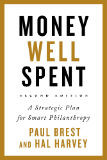
Money Well Spent: A Strategic Plan for Smart Philanthropy, 2nd edition
Paul Brest and Hal Harvey
392 pages, Stanford Business Books, 2018
Paul Brest and Hal Harvey’s substantially revised second edition of Money Well Spent shows they have listened to their own new experiences, their critics, and many other scholars and practitioners.
In 2008, when their first edition was published, Brest was well into his tenure as the William and Flora Hewlett Foundation’s president, and Harvey was a seasoned Hewlett grantmaker and environmental advocate. They combined forces to explain and defend what had come to be called “strategic philanthropy”—grantmaking that improves the odds of achieving results by focusing relentlessly on goals, evidence, and outcomes.
But where they (and other strategic philanthropy proponents) saw a common-sense need for rigor and discipline, others found plenty to criticize, worrying about top-down strategies that too often ignore the firsthand knowledge of leaders on the front lines. When Susan Berresford, a former Ford Foundation president, reviewed the book’s first edition in these pages, she praised the authors but chided them for imparting “little understanding of what it is like to be on the other side of the table.”
By 2016, Harvey himself joined the debate, offering an apology in The Chronicle of Philanthropy titled “Why I Regret Pushing Strategic Philanthropy.” He had moved on from Hewlett to lead ClimateWorks Foundation and then to direct a policy advisory firm, where he experienced the damage done by arrogant funders who assumed they knew best, insisting on overly precise strategies and rigid accountability structures. Meanwhile, Brest left the Hewlett Foundation in 2012, joined the Stanford Center on Philanthropy and Civil Society (the publisher of Stanford Social Innovation Review) as a faculty codirector, and incorporated his own additional learning into his teaching.
It’s no surprise that the two authors teamed up to produce this update, which showcases how much they—and the field—have learned from an additional decade of practice, debate, and reflection. The second edition covers the same basics, but in an even richer and more nuanced way. Every major decision a funder must make is explained, from framing problems and developing solutions, to combining tools and structures, to using data and designing evaluations. Particularly enlightening are the expanded examples, including the skillful extended case study on homelessness across several early chapters, and many recent illustrations depicting advocacy strategies.
One highlight is their new chapter on “Impact Investing and Mission Investments,” a field that has rocketed into prominence since the first edition. They have somehow managed to distill a complicated subject into a concise and forceful argument that will guide newcomers while challenging experienced investors to set higher standards for success and impact.
Again and again, I found Brest and Harvey stretching beyond the easy stereotypes of past debates. They seem determined not to be misread as providing a simple recipe for complex decision making, arguing that there is no substitute in the end for judgment and wisdom. And they are clear that good nonprofit leaders should be given the benefit of the doubt.
Readers may still feel, as I did, that the authors’ tone can at times feel too pedantic, like a lecture from a professor who can’t hide his condescension. For instance, the authors can’t help but scold those who “cite the supposed wickedness of problems as an excuse for avoiding the hard work of strategic problem solving.”
Whatever happened to "giving" as a way to
approach some of philanthropy, rather than always
insisting up front on "money well spent"?
My heart longed for the creativity and imagination of the humanist sensibility to go with the social science rigor of Money Well Spent. I have learned the hard way that character and courage often matter as much or more than strategy. I have watched as circumstances shift and shift again, making a mockery of linear theories of change. And I have witnessed funders foolishly waste time and money as they hold tight to strategic control. I sometimes wonder: Whatever happened to giving as a way to approach some of philanthropy, rather than always insisting up front on “money well spent”?
Brest and Harvey wisely do not try to relitigate these and many other doubts about strategic philanthropy. Instead they focus on making their own updated case in the most compelling way. By all means, take the time to understand the context surrounding their work, which was thoroughly presented in an April 2015 “Up for Debate” package on SSIR’s website, “Strategic Philanthropy and Its Discontents.” But also give Brest and Harvey the benefit of the doubt. The second edition of Money Well Spent is an indispensable addition to the growing genre of philanthropic advice.

